heating FIAT 600 2007 1.G Owners Manual
[x] Cancel search | Manufacturer: FIAT, Model Year: 2007, Model line: 600, Model: FIAT 600 2007 1.GPages: 146, PDF Size: 2.05 MB
Page 11 of 146

10GETTING TO KNOW YOUR CAR
AIRBAGPRETENSIONERS
AND
CLOCK SPRING2019
07
2018 2017
01 02 03 04 05 06
08 09 10 11 122015
07
2014 2013
01 02 03 04 05 06
08 09 10 11 12
ATTENZIONE:
CAUTION:
ACHTUNG: ATTENTION:
fig. 7a
P4Q00226
Operations which lead
to knocks, vibrations or
localised heating (over
100°C for a maximum of 6
hours) in the area around the
pretensioners may cause damage
or trigger them. These devices
are not affected by vibrations
caused by irregularities of the
road surface or low obstacles
such as kerbs, etc. Contact a Fiat
Dealership for any assistance.A small amount of smoke may be
produced. This smoke is in no way
toxic and presents no fire hazard.
The pretensioner does not require
any maintenance or greasing. Anything
that modifies its original conditions in-
validates its efficiency. If due to unusual
natural events (floods, sea storms,
etc.) the device has been affected by
water and mud, it must necessarily be
replaced.
The pretensioner can
only be used once.
After a collision that has
triggered it, have it replaced at
a Fiat Dealership. The validity of
the device is written on the plate
located on the front left door
post. The pretensioners should
be replaced at a Fiat Dealership
as this date approaches.PRETENSIONERS
In order to make the safety belt pro-
tective action even more efficient, ve-
hicle is equipped with pretensioners
on driver side and on front passenger
side (if car is equipped with passen-
ger side air bag option), that, in case
of a violent front crash, recall the safe-
ty belt by a few cm, thus ensuring
proper adherence of safety belt to pas-
senger body, before the retaining ac-
tion starts.
The seat belt locks to indicate that
the device has intervened; the seat belt
cannot be drawn back up even when
guiding it manually.
IMPORTANTTo obtain the high-
est degree of protection from the ac-
tion of the pretensioning device, wear
the seat belt keeping it firmly close to
the chest and pelvis.
001-069 Seicento GB 22-11-2007 10:49 Pagina 10
Page 20 of 146
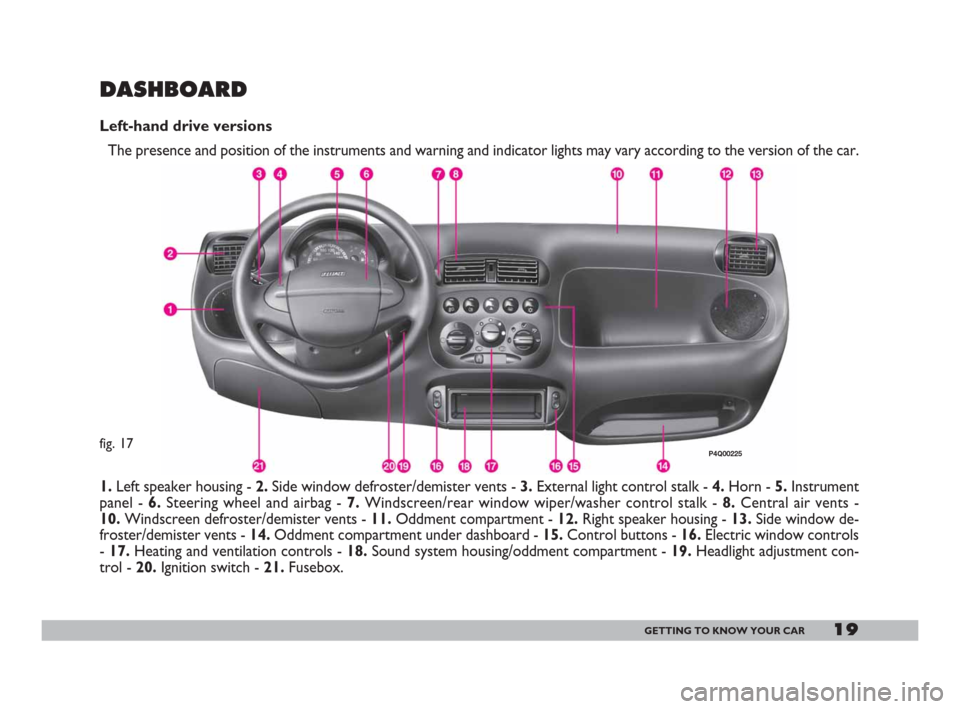
19GETTING TO KNOW YOUR CAR
DASHBOARD
Left-hand drive versions
The presence and position of the instruments and warning and indicator lights may vary according to the version of the car.
1.Left speaker housing - 2.Side window defroster/demister vents - 3.External light control stalk - 4.Horn - 5.Instrument
panel - 6.Steering wheel and airbag - 7.Windscreen/rear window wiper/washer control stalk - 8.Central air vents -
10.Windscreen defroster/demister vents - 11.Oddment compartment - 12.Right speaker housing - 13.Side window de-
froster/demister vents - 14.Oddment compartment under dashboard - 15.Control buttons - 16.Electric window controls
- 17.Heating and ventilation controls - 18.Sound system housing/oddment compartment - 19.Headlight adjustment con-
trol - 20.Ignition switch - 21.Fusebox.
P4Q00225fig. 17
001-069 Seicento GB 22-11-2007 10:49 Pagina 19
Page 33 of 146
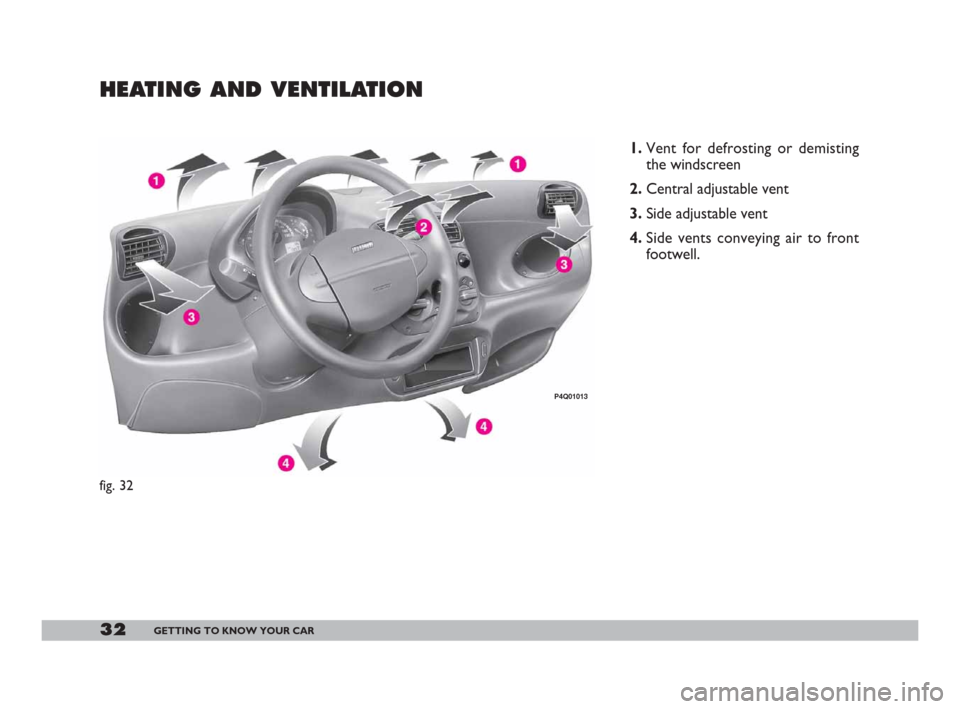
32GETTING TO KNOW YOUR CAR
HEATING AND VENTILATION
1.Vent for defrosting or demisting
the windscreen
2.Central adjustable vent
3.Side adjustable vent
4.Side vents conveying air to front
footwell.
fig. 32
P4Q01013
001-069 Seicento GB 22-11-2007 10:49 Pagina 32
Page 34 of 146

33GETTING TO KNOW YOUR CAR
DIRECTIONAL AND
ADJUSTABLE AIR VENTS
fig. 33
The vents can be rotated upwards
or downwards.
A- Control for adjusting air flow:
turned to ¥vent open.
turned to çvent closed.
B- Control for directing air flow.
C- Fixed vent for side windows.CONTROLS fig. 34
A- Air temperature knob (mixing
hot and cold air).
B- Fan knob .
C- Air distribution knob.
D- Air recirculation slider. This pre-
vents air from being taken in from the
outside.HEATING
1)Air temperature knob A-fig. 34:
pointer in the red sector.
2)Fan knob B: pointer at required
speed.
3)Air distribution knob C: pointer at:
≤to warm the feet and demist the
windscreen at the same time;
¥to direct air to the central and
side vents;
μto warm the feet and keep the
face cool (intermediate position);
wto heat when the outside tem-
perature is especially low: to send
most air to the footwell, close the
central and side vents;
-to rapidly demist the windscreen.
fig. 33
P4Q00047
fig. 34
P4Q00019
001-069 Seicento GB 22-11-2007 10:49 Pagina 33
Page 35 of 146
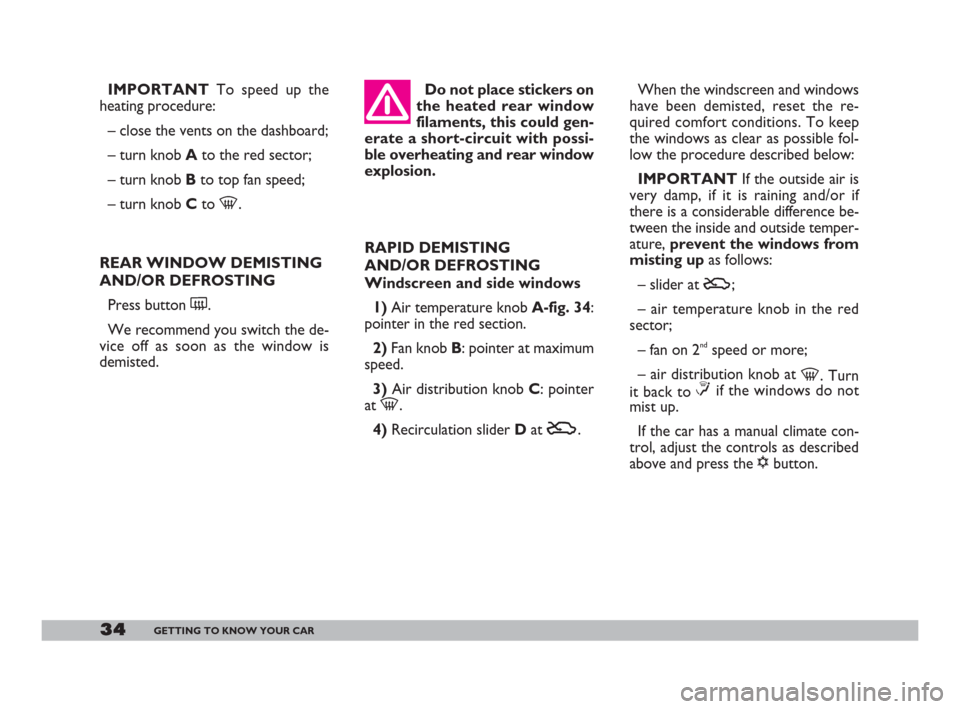
34GETTING TO KNOW YOUR CAR
IMPORTANTTo speed up the
heating procedure:
– close the vents on the dashboard;
– turn knob Ato the red sector;
– turn knob Bto top fan speed;
– turn knob Cto -.
REAR WINDOW DEMISTING
AND/OR DEFROSTING
Press button (.
We recommend you switch the de-
vice off as soon as the window is
demisted.Do not place stickers on
the heated rear window
filaments, this could gen-
erate a short-circuit with possi-
ble overheating and rear window
explosion.
RAPID DEMISTING
AND/OR DEFROSTING
Windscreen and side windows
1)Air temperature knob A-fig. 34:
pointer in the red section.
2)Fan knob B: pointer at maximum
speed.
3)Air distribution knob C: pointer
at -.
4)Recirculation slider Dat U. When the windscreen and windows
have been demisted, reset the re-
quired comfort conditions. To keep
the windows as clear as possible fol-
low the procedure described below:
IMPORTANTIf the outside air is
very damp, if it is raining and/or if
there is a considerable difference be-
tween the inside and outside temper-
ature, prevent the windows from
misting up as follows:
– slider at
U;
– air temperature knob in the red
sector;
– fan on 2
ndspeed or more;
– air distribution knob at
-. Turn
it back to≤if the windows do not
mist up.
If the car has a manual climate con-
trol, adjust the controls as described
above and press the √button.
001-069 Seicento GB 22-11-2007 10:49 Pagina 34
Page 37 of 146

36GETTING TO KNOW YOUR CAR
CLIMATE CONTROL
(Cooling)
1)Air temperature knob A-fig. 35:
pointer in the blue sector.
2)Climate control: press button √E.
3)Slider D: at T.
4)Fan knob B: pointer at required
speed.
5)Air distribution knob C: pointer
at ¥.
To decrease cooling effects: set
pointer to
U, increase temperature
and decrease fan speed.
For normal heating and ventila-
tion , do not use the manual climate
control system. Use the normal heat-
ing and ventilation system instead (see
following chapter).IMPORTANTThe manual climate
control system is very useful for
speeding up the demising process be-
cause it dries the air. Simply adjust the
controls for the demistingfunction
(see previous section) and switch the
manual climate control system on by
pressing knob √. SYSTEM MAINTENANCE
During the winter, the climate con-
trol system must be turned on at least
once a month for about ten minutes.
Have the system and pollen filter ef-
ficiency checked before the summer
at a Fiat Dealership.
The system is filled with
R134a refrigerant which
will not pollute the envi-
ronment in the event of leakage.
Under no circumstances should
R12 fluid be used as it is incom-
patible with the system compo-
nents and contains CFC.
001-069 Seicento GB 22-11-2007 10:49 Pagina 36
Page 75 of 146
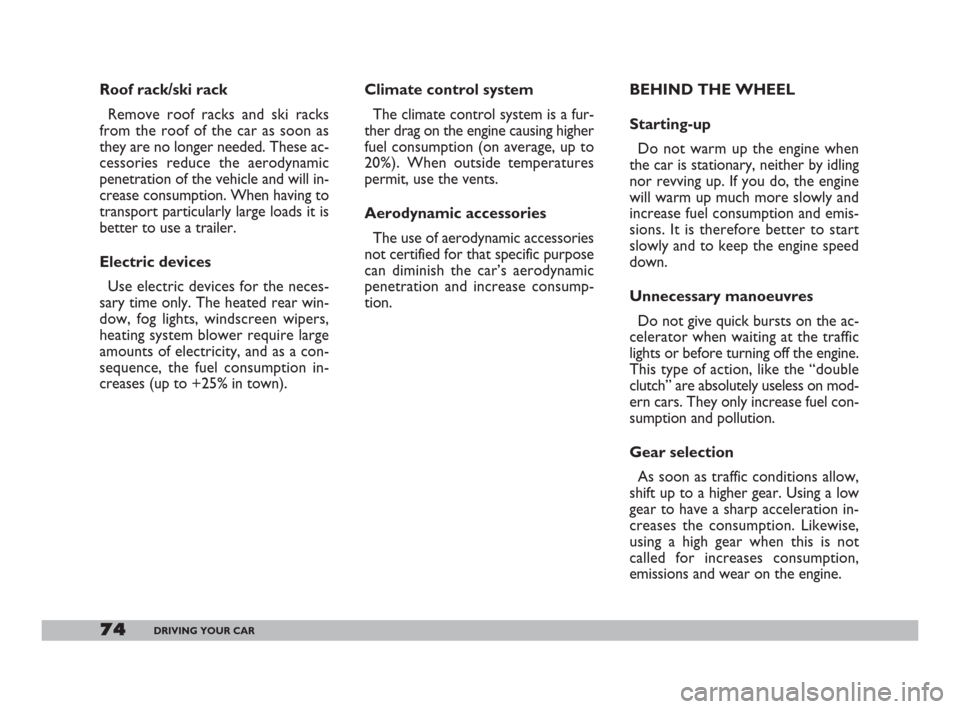
74DRIVING YOUR CAR
Climate control system
The climate control system is a fur-
ther drag on the engine causing higher
fuel consumption (on average, up to
20%). When outside temperatures
permit, use the vents.
Aerodynamic accessories
The use of aerodynamic accessories
not certified for that specific purpose
can diminish the car’s aerodynamic
penetration and increase consump-
tion.BEHIND THE WHEEL
Starting-up
Do not warm up the engine when
the car is stationary, neither by idling
nor revving up. If you do, the engine
will warm up much more slowly and
increase fuel consumption and emis-
sions. It is therefore better to start
slowly and to keep the engine speed
down.
Unnecessary manoeuvres
Do not give quick bursts on the ac-
celerator when waiting at the traffic
lights or before turning off the engine.
This type of action, like the “double
clutch” are absolutely useless on mod-
ern cars. They only increase fuel con-
sumption and pollution.
Gear selection
As soon as traffic conditions allow,
shift up to a higher gear. Using a low
gear to have a sharp acceleration in-
creases the consumption. Likewise,
using a high gear when this is not
called for increases consumption,
emissions and wear on the engine. Roof rack/ski rack
Remove roof racks and ski racks
from the roof of the car as soon as
they are no longer needed. These ac-
cessories reduce the aerodynamic
penetration of the vehicle and will in-
crease consumption. When having to
transport particularly large loads it is
better to use a trailer.
Electric devices
Use electric devices for the neces-
sary time only. The heated rear win-
dow, fog lights, windscreen wipers,
heating system blower require large
amounts of electricity, and as a con-
sequence, the fuel consumption in-
creases (up to +25% in town).
070-082 Seicento GB 22-11-2007 10:50 Pagina 74
Page 100 of 146
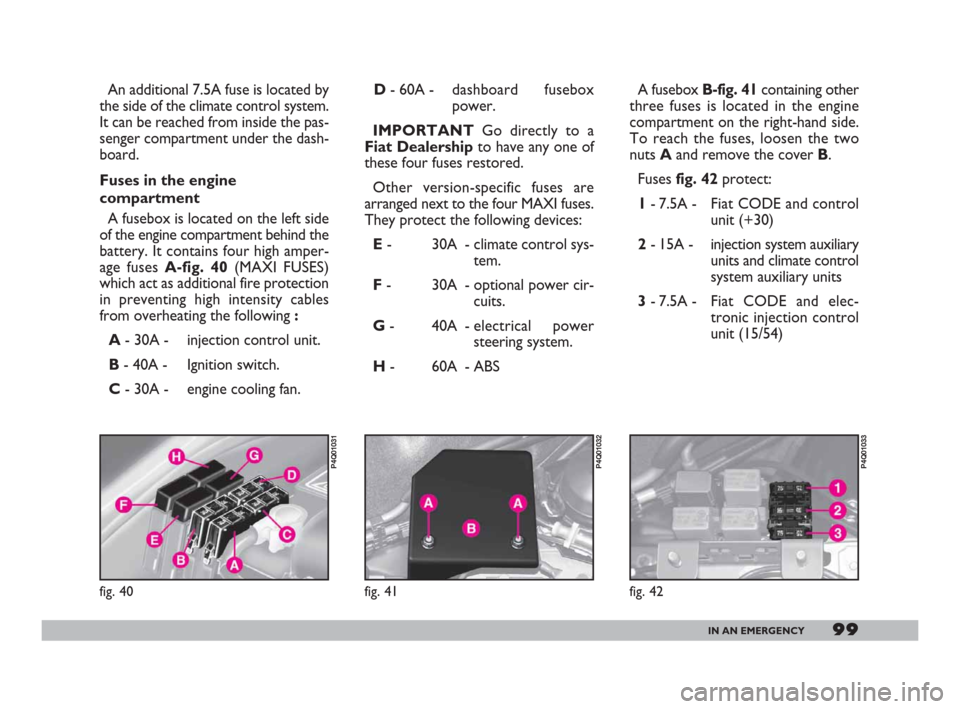
99IN AN EMERGENCY
An additional 7.5A fuse is located by
the side of the climate control system.
It can be reached from inside the pas-
senger compartment under the dash-
board.
Fuses in the engine
compartment
A fusebox is located on the left side
of the engine compartment behind the
battery. It contains four high amper-
age fuses A-fig. 40 (MAXI FUSES)
which act as additional fire protection
in preventing high intensity cables
from overheating the following :
A- 30A - injection control unit.
B- 40A - Ignition switch.
C- 30A - engine cooling fan.D- 60A -dashboard fusebox
power.
IMPORTANT Go directly to a
Fiat Dealershipto have any one of
these four fuses restored.
Other version-specific fuses are
arranged next to the four MAXI fuses.
They protect the following devices:
E - 30A - climate control sys-
tem.
F - 30A - optional power cir-
cuits.
G - 40A - electrical power
steering system.
H - 60A - ABSA fusebox B-fig. 41 containing other
three fuses is located in the engine
compartment on the right-hand side.
To reach the fuses, loosen the two
nuts A and remove the cover B.
Fuses fig. 42 protect:
1 - 7.5A -Fiat CODE and control
unit (+30)
2 - 15A -injection system auxiliary
units and climate control
system auxiliary units
3 - 7.5A -Fiat CODE and elec-
tronic injection control
unit (15/54)
fig. 40
P4Q01031
fig. 41
P4Q01032
fig. 42
P4Q01033
083-104 Seicento GB 22-11-2007 10:50 Pagina 99
Page 120 of 146

119CAR MAINTENANCE
Changing the windscreen
wiper blade
1) Lift the windscreen wiper arm A-
fig. 9off the glass and position the
blade so as to form a right angle with
the arm.
2) Press tab B on the retainer and
remove the blade to be replaced from
arm A.
3) Fit the new blade by inserting the
tab into the special slot in the arm.
Make sure it is properly locked into
place.Changing the rear window
wiper blade
1) Lift the coverA-fig. 10and dis-
mantle the arm from the vehicle by
unscrewing the nut B-fig. 11which
holds it onto the knuckle.
fig. 9
P4Q00131
fig. 10
P4Q00132
fig. 11
P4Q00133
Never operate the wind-
screen wiper with blades
locked to the windscreen:
risk of windscreen wiper motor
overheating / damaging.
Some simple steps can reduce po-
tential damage to the blades:
– If the temperature falls to below
zero, make sure the rubber blade is
not frozen to the windscreen. If nec-
essary, free it with a de-icing com-
pound.
– Remove any snow that has settled
on the glass: besides saving the blades
you will avoid straining the electric
windscreen wiper motor and causing
it to overheat.
– Do not operate the windscreen or
rear window wipers on dry glass.
105-123 Seicento GB 22-11-2007 10:51 Pagina 119
Page 139 of 146
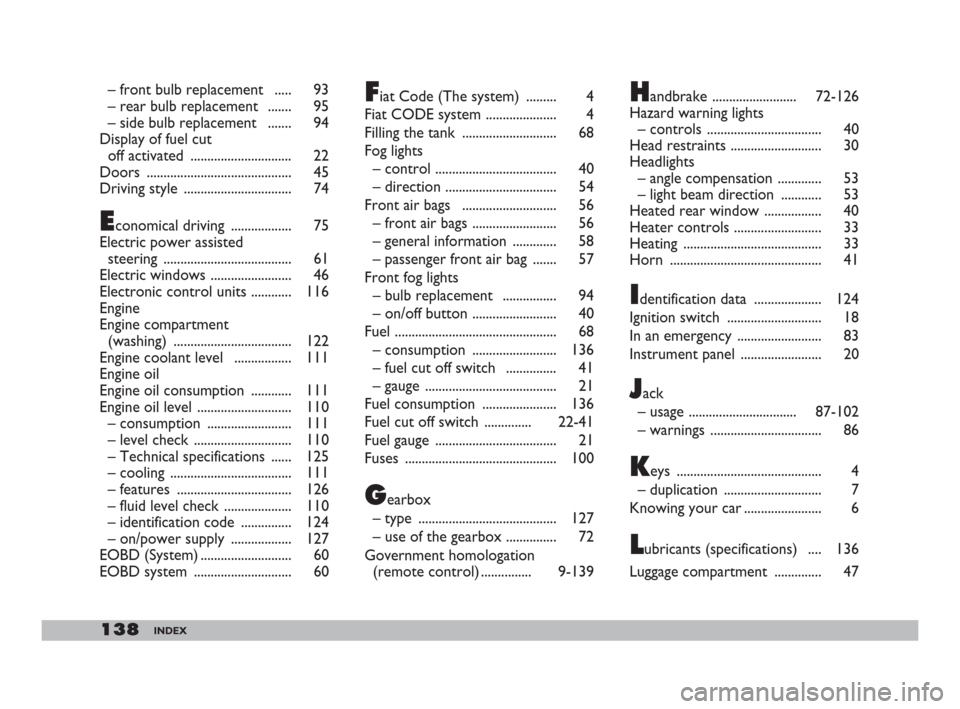
138INDEX
– front bulb replacement ..... 93
– rear bulb replacement ....... 95
– side bulb replacement ....... 94
Display of fuel cut
off activated .............................. 22
Doors ........................................... 45
Driving style ................................ 74
Economical driving .................. 75
Electric power assisted
steering ...................................... 61
Electric windows ........................ 46
Electronic control units ............ 116
Engine
Engine compartment
(washing) ................................... 122
Engine coolant level ................. 111
Engine oil
Engine oil consumption ............ 111
Engine oil level ............................ 110
– consumption ......................... 111
– level check ............................. 110
– Technical specifications ...... 125
– cooling .................................... 111
– features .................................. 126
– fluid level check .................... 110
– identification code ............... 124
– on/power supply .................. 127
EOBD (System) ........................... 60
EOBD system ............................. 60
Fiat Code (The system) ......... 4
Fiat CODE system ..................... 4
Filling the tank ............................ 68
Fog lights
– control .................................... 40
– direction ................................. 54
Front air bags ............................ 56
– front air bags ......................... 56
– general information ............. 58
– passenger front air bag ....... 57
Front fog lights
– bulb replacement ................ 94
– on/off button ......................... 40
Fuel ................................................ 68
– consumption ......................... 136
– fuel cut off switch ............... 41
– gauge ....................................... 21
Fuel consumption ...................... 136
Fuel cut off switch .............. 22-41
Fuel gauge .................................... 21
Fuses ............................................. 100
Gearbox
– type ......................................... 127
– use of the gearbox ............... 72
Government homologation
(remote control) ............... 9-139
Handbrake ......................... 72-126
Hazard warning lights
– controls .................................. 40
Head restraints ........................... 30
Headlights
– angle compensation ............. 53
– light beam direction ............ 53
Heated rear window ................. 40
Heater controls .......................... 33
Heating ......................................... 33
Horn ............................................. 41
Identification data .................... 124
Ignition switch ............................ 18
In an emergency ......................... 83
Instrument panel ........................ 20
Jack
– usage ................................ 87-102
– warnings ................................. 86
Keys ........................................... 4
– duplication ............................. 7
Knowing your car ....................... 6
Lubricants (specifications) .... 136
Luggage compartment .............. 47
137-144 Seicento GB 28-11-2007 9:38 Pagina 138